As parents, have you ever wondered when the car seats were designed? What were the first child restraint systems, and how did they look like?
More importantly, did our parents use the child safety car seats when we were children? Do we still have them?
That's why I dug up a bit and found remarkable facts regarding the history of baby car seats!
Are you ready? I will take you on the journey of your life!
More...
A Complete Car Seat History: The Ancient + The Modern History (1930-2022)
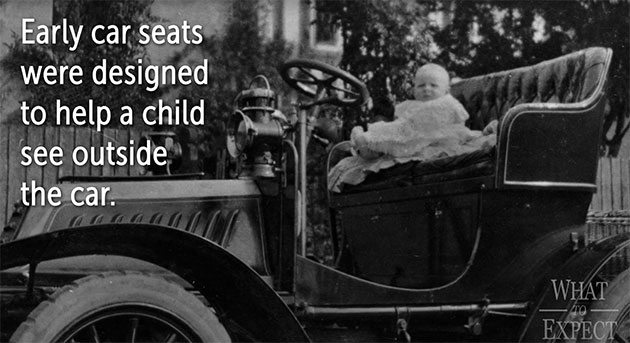
Source: YouTube
1. Car Seats in the 1930s
Officially, the baby car seat history begins in the fourth decade of the 20th century.
During the 1930s, the first baby monitor was invented. But before that, there were no records of child car seats.
So, the first child car seat was designed in 1933 by the Bunny Bear Company.
However, this child passenger safety restraint system was everything but safe! The car seat did not have any safety features.
Although the Bunny Bear Company designed unsafe child car seats, parents used them for a different purpose.
Their main goal was to elevate children; therefore, the parents could see them better in the vehicles.
For this reason, parents used tremendously unsafe booster car seats, placed kids inside, and had a better insight into their actions.
But, later on, this will change with the newer design and improved safety standards.
However, the Bunny Bear Company primarily focused on creating a car seat that would prevent kiddo from moving in the motor vehicle and help parents with supervision.
Therefore, the Bunny Bear Company invented the first booster seat. Yet, it lacked safety.
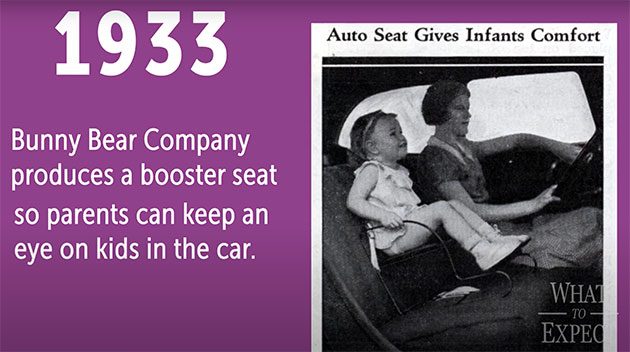
Source: YouTube
2. Car Seats in the 1940s
The baby car seat history didn't change too much during the following period.
The manufacturers produced different car seat options, but all of them had one common feature: the seats were made of canvas with a metal frame.
So, the first child car seats consisted of not-so-comfortable parts.
What's exciting about these seats is the fact that they were placed in the front passenger seat. This way, children could better observe the world outside through the windshield.
In addition, parents used metal hooks to attach the seats correctly.
And, they still didn't pay much attention to the safety features.
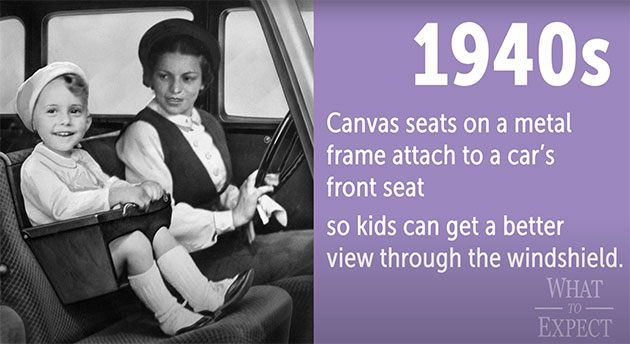
Source: YouTube
3. Car Seats in the 1950s
Now, during this period, we may notice a slight difference in terms of safety and security. But, only a minute.
The 1950s are interesting since, in these years, the well-known Toidey Company released the famous advertisement about the car safety seat belt.
According to the ad, the company claimed kids were riding securely and comfortably in car seats due to anchors that kept seats stable both in the front and back seats of the vehicles.
Although there are no records of car seat safety tests, crash testing, regulations, and standards, we have to admit, the conditions were somewhat "better," which marked the beginning of the car safety seats.
But, if you compare these child safety seats with our present child restraints, the past child seats were far from fulfilling their safety standards and the correct car seat usage.
Yet, they did accommodate children. Parents used them as extra high chairs for kids at home, too.
Still, we cannot really expect maximum safety standards in the early car seat history.
If we take a step back, cars were invented during the 1900s.
Therefore, even motor vehicles lacked the basic security standards that would appear later in the 20th century.
Remember - the first 3-point seat belt system appeared in 1959. Designed as the shoulder-lap belt and offered only moderate security.
So, the car seats gradually improved and advanced in the years coming.
4. Car Seats in the 1960s
Now, the second half of the 20th century presents a turning point in child safety seats.
Even though it took them 30 years to produce the child safety seat with security in mind, the car seat manufacturers finally created the correct child passenger safety systems.
The first prominent year is 1962. So, we have a producer with the actual safe car seat in mind.
Her name was Jane Helen Ames.
As a mother, she is highly acknowledged for insisting on child safety seats for little ones, as she also had a son.
So, she designed a rear-facing car seat, crucial for its Y-shaped seat belt to restrain the children correctly in car collisions.
But she didn't stop here.
Namely, in 1965 she also patented two 5-point harness systems, like present units, with the same high-quality content and strong buckles.
According to numerous sources, the 5-point harness contained British nylon and a quick-release, parachute-style, tamper-resistant center buckle.
So, it was both comfortable and stable for kids to remain longer in the child safety seat.
In addition, we got the first rear-facing seat with these two benefits - the Jeenay car seat, named after the English journalist.
On the other hand, after a car accident where his son flew from the back seat to his mother's feet, a Denver businessman Leonard Rivkin invented the car seat with the iron-framed booster seat.
This booster seat started a revolution in the history of car seats, thanks to the five-point harness system.
Next off, another significant year that marked a turning point in car seat history is 1964. Now, the 64 is exceptional due to the Swedish professor Bertil Adman.
This man appreciated the protection the rear-facing car seats offered. So, he created the first rear-facing car seat ever!
In cooperation with the researcher Thomas Turbell, the duo and Sweden patented and released the famous T-standard, characteristic for rear-facing seats.
Basically, they didn't allow the forward-facing seats to pass.
Moreover, the outstanding duo set the rules that Swedish children must be in the rear seat until they're four years old. The same tradition and laws still apply even today.
However, the year 1965 is also prominent in car seat history.
That year, Art Hoffman's team of experts at GM gave their votes to seats instead of vests and also created their first infant seat.
The car seat was called a love seat, and General Motors & Art Hoffman disregarded the unsafe booster seats created previously by the Bunny Bear Company.
Concerning the 1960s, another valuable year is undoubtedly 1968.
This year is significant as the Ford Motor Company created and launched the Tot-Guard car seat. The Tot-Guard was a plastic chair for kids to cut the story short.
But, the basic seat featured a plastic frame supporting upper body parts and restraint, keeping kids stable and fixed. Also, it was an extraordinary invention due to the safety benefits.
As you might find, the Tot-Guard included a soft cushion that could catch and protect the child's face in a motor vehicle accident. So, the brand designed the first relatively safe car seat.
And in 1969, the Steel Travel Platform was introduced by Sewers; however, safety was still in the process.
So, the device consisted only of a steel plate covered with just a vinyl pad that kids could sleep, sit, stand, lay or play in the car basket.
I will only briefly mention that seat belts were not so popular in this period, though they saved lives.
So, the DOT - Department of Transportation and Congress passed the law to regulate the rules for vehicle design.
So, the states could enforce different laws, ensuring the use of front and side airbag systems, self-applying belts, and shoulder harnesses.
But, most importantly - they demanded the proper restraining system in the car seat - either harness or seat belt according to the model.
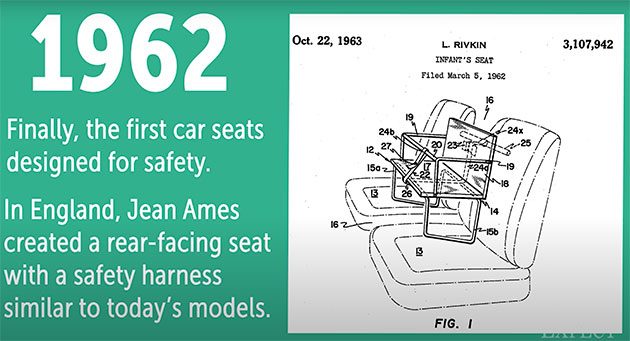
Source: YouTube
5. Car Seats in the 1970s
Finally, parents and manufacturers could count on safety benefits and standards!
Though it took them almost ten years to combine the safety-conscious car seats & their existing regulations and apply, the standards were official!
In 1971, the NHTSA - National Highway Traffic Safety Administration set the first federal standards, known as the Federal Motor Vehicle Safety Standards - FMVSS213.
The child passenger safety rules demand the use of seat belts to keep the seat stable in the back seat of the vehicle and a harness system to keep the child stable and secure inside the seat.
However, they did not include the crash tests.
For this reason, in 1972, the Consumer Reports published an article claiming that most car seats that passed the FMVSS213 could not resist rigorous crash tests.
In 1971, the Action for Child Transportation Safety had an uphill task to promote child passenger safety and security on the road and became the predecessor to the child restraints developed in 1982.
However, in 1978 the world got the Bobby Mac convertible seat. The Bobby Mac car seat is the first and forerunner of the present, modern convertible car seats.
The car seat came with the instruction manual, 4-point harness, and safety belt, but it lacked the chest clip, plastic shell and pads, and several metal clips, too cumbersome to adjust to the harness straps.
It also had the EPP/EPS energy-absorbing foam and three recline positions.
Although it lacked numerous safety features, it is still worth mentioning and an excellent example to see how far we have gone in advancing child safety seats.
Finally, in 1979 the state of Tennessee got the first car seat safety law.
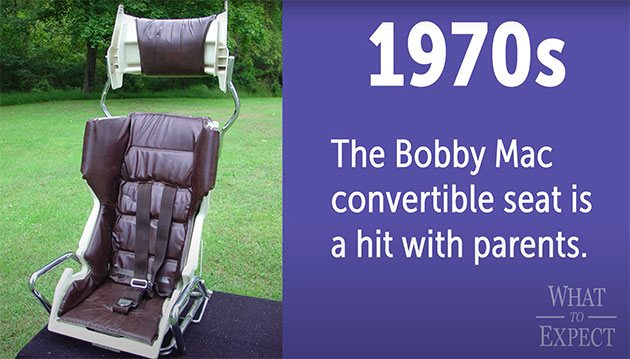
Source: YouTube
6. Car Seats in the 1980s
By 1985, all US states had their child passenger safety laws, requiring numerous rules and regulations regarding installation, car seat ages, stages, etc.
But, even in 1987, only 80% of children used a proper child car seat.
However, during the 80s, crash tests became an obligatory part of every child's car seat safety use.
Many state car seat laws also supported this and provided numerous rules that even manufacturers, safety technicians, and other child car seat experts had to obey.
And, in 1985, the NHTSA conducted a research where the data showed that 85% of child restraints were installed and misused.
Finally, in 1988, the organization Safe Kids Worldwide was founded by the M.D., a pediatric trauma surgeon Martin R. Eichelberger, and Herta Feely, a public relations professional at Children's National Hospital in Washington, DC.
During these 34 years, they have lent a helping hand in solving all issues regarding seats, finding authorities, car seat laws, and verified safety technicians.
So, as you can see, even we as kids used proper child restraint systems per the law and given design technology.
But, most importantly, we were safe, as our parents made sure they followed the rules.
7. Car Seats in the 1990s
The 1990s were a milestone in car seat history, as now we have aircraft use.
During this period, the Federal Aviation Administration - FAA required airlines to permit seats on the plane.
However, the models must have been approved by the FAA, and unlike other car seats, they had weight and size limits and other requirements.
Even today, you can take your car seat on the plane, but only as a rear-facing or a forward-facing seat with a harness.
The FAA forbids uses booster seats on the plane, so the other two versions are the only suitable variants.
Also, during the 1990s, the NHTSA proposed and accepted even stricter federal standards. These standards for car seat safety require:
- rear-facing infant seats, beds, and forward-facing seats for kids under 50 pounds,
- buckle release force to prevent kids from unbuckling,
- frontal crash tests at 30 mph,
- individual instructions and manuals, and specific labeling.
Due to the seat belt syndrome, the laws regulated that seat belts became obligatory in the rear-facing infant car seats for better safety.
However, wearing safety belts didn't really cover all crucial points, so the authorities had to change some parts of the law to achieve what we have today.
The turn regarded airbags and sitting on the front seat in the vehicle.
But later on, we will explain it better.
1995 is essential, as the Blue Ribbon Panel examined and estimated the compatibility of restraint systems and motor vehicles. Finally, they presented the ISOFIX system.
The ISOFIX, in all its design and benefits, was officially launched in 1997 as a former model of today's LATCH system.
Since it's a forerunner, it didn't have the exact safety features the LATCH has nowadays.
Still, it was the first attempt to secure child car seats with anchor points and connectors.
And, the last but not most petite year in this period of car seat history and modernization is undoubtedly 1997. So, why is this year crucial?
Well, in partnership with the NHTSA and the National Child Safety Passenger Board, Safe Kids Worldwide established the Child Passenger Safety Technician Program.
The safety technicians are experts trained to help you and guide you through the car seat installation, check, and examination.
The organization verifies them, and you can find them on the official Safe Kids and NHTSA websites or check if you have some nearby.
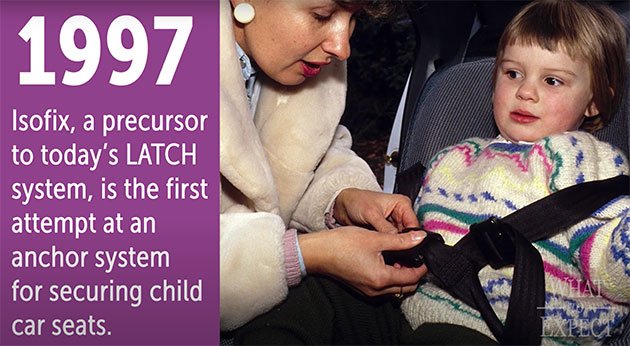
Source: YouTube
8. Car Seats in the 2000s & Modern History
The (not so) modern history of car seats begins in the 2000s. Then, however, it marked the whole dimension of the seats that we know today.
We finally got numerous infant, convertible, and booster seats with a huge step up. However, the travel system car seats also made their debut in the USA.
In 2002, the law required the LATCH - Lower Anchors Tethers for Children.
Simultaneously, California and Washington accept and propose the first booster seat laws for all kids weighing more than 40 pounds.
Numerous other states follow the models and pass similar laws.
However, in 2003, all produced motor vehicles had to have complete systems to protect children.
The primary purpose of the lower and the top tether anchor points is to make the installation procedure more straightforward and add more stability to the seat in case of a car collision.
But this was just the beginning.
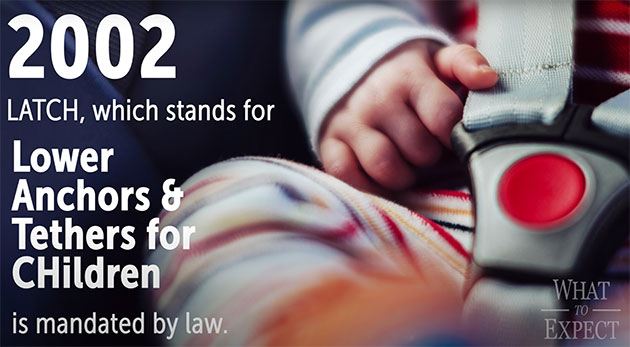
Source: YouTube
The Current Car Seat History
Even now, the safety laws propose and implement rigorous safety tests and regulations that only continue to evolve.
Also, the manufacturers determine the seat expiration dates, and parents consider safety recalls very seriously, which is excellent.
But, we still lack 100% use of safety seats.
The disappointing fact is that we still have 75% of incorrect seat installation and use.
So, parents, please, contact your safety experts if you're not sure how to place and set up the seat into the vehicle properly.
Other law parts with the American Academy of Pediatrics - AAP state that younger children MUST ride in the rear-facing infant restraints as long as possible.
So, parents mustn't hurry and place them in the forward-facing or even boosters if they're not ready.
Regarding the car seat requirements, ages, and stages, the law introduces specific models for kids younger than two, two to four, four to eight, eight to twelve years old, etc.
The crucial part is that the seats must be placed in the back seat of your vehicle, with the seat belts, harness, and properly installed.
You mustn't place the seat in the front seat next to you, especially with the airbag system turned on.
But, in case that you must, you need to turn the airbag system off.
This is essential for younger children, as the pressure and forces will literally smash them.
And, in many states, kids under thirteen are not allowed to ride in the front seat.
But, once they're thirteen, they can use the safety belt instead of chairs and harnesses, but the safety belt must cover their upper thighs, shoulder, and chest.
Otherwise, they won't be ready for seat belts.
And, of course, no booster seat is allowed on the plane. Whether the FAA will change its stance, we will have to wait patiently and see.
Many parents would like this, as it might be challenging to travel with a child that needs a booster, it's not ready for a plane seat, but they outgrew the harness system.
However, we need to follow the regulations to keep our little ones safe.
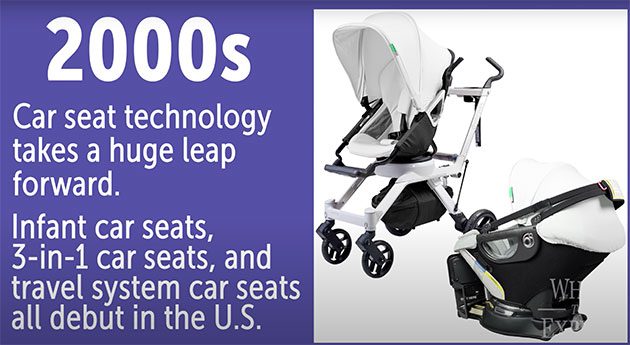
Source: YouTube
The Future Car Seat History
We all expect significant changes in the near and far future, as standards develop, improve and we have new products even at present.
One such innovation is the RideSafer Travel Vest.
The unit is excellent as it adds more security and stability for the kids on the plane.
Another worthy innovation is the Tummy Shields, a crash-tested pregnancy seat belt adjuster designed to protect you and your unborn baby in the event of a car collision.
However, the best results and safest rides are adequate car seat installation, proper restraint systems, and careful examination. At least, that's what databases have shown so far.
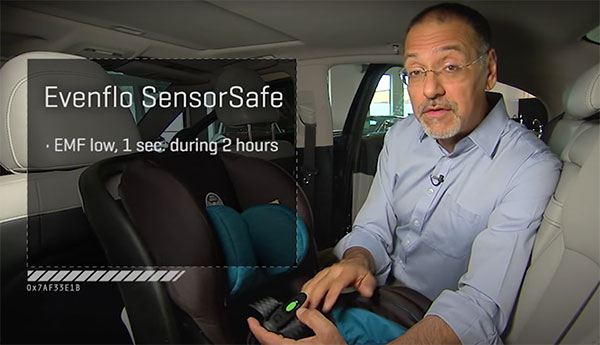
Source: YouTube
Frequently Asked Questions
1. Did they have car seats in the 80s?
Yes, they did.
As you can see, the Bobby Mac convertible car seat was presented in 1978, and it was a prevalent model among parents.
However, numerous other car seat models were released as well, with similar or different features so that you could choose among them.
In addition, most harnessed seats were three-point harness models, with a crotch strap connected to the V-shaped belt but without chest clips or hip straps.
So, the harness systems were not as safe as they're today.
2. Were there car seats in the 50s?
Yes, there were car seats designed during that time.
These car seats used to have three-point seat belts, although they appeared in the late 1950s.
3. When did car seats become common?
Well, the most considerable expansion in the baby car seat history is definitely between 1960 and 1970.
First, numerous designers created various models and later on launched them.
However, once the authorities passed the safety laws from the 1970s, manufacturers and experts paid more attention to the overall safety and stability.
Of course, with the development of modern technology from this point until now, we have hundreds of thousands of models, with similar but different benefits.
4. What did parents do before car seats?
Before the first car seat, parents used the burlap sacks with a drawstring. They would hang them on the headrest on the front passenger seat, next to them.
And, in 1933, the Bunny Bear Company introduced the first booster seat. The parents could now place their children in the back seat of their vehicle.
Final Words
Wow, this is a looong car seat history!
We had covered almost 100 years from when were carseats invented.
Starting with the canvas seats with the metal frame surrounded by a buckle to the plastic shells with extra pads to current material with breathable content.
Can you imagine what will happen in years to come and the future history of car seats?
It's a long journey, but I think the best is yet to come.
Since technology develops rapidly, so do the car seat manufacturers, and who knows what the future holds.
Still, we'll wait and see, and until the moment comes, you can enjoy a fantastic retrospective and find as much as possible of the "retro" car seat models.

Hi Kathy, great article. I actually have a collection of those vintage car seats! The photo of the Bobby Mac is actually mine. You have my email if you would like to contact me. Thanks